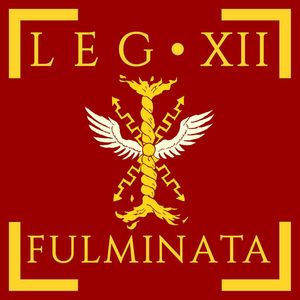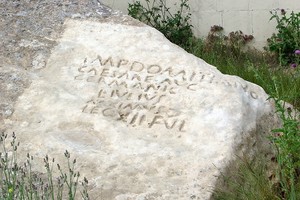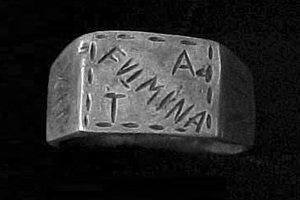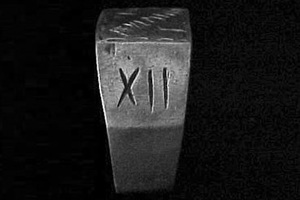Roman Legion - Legio XII Fulminata
Legio XII Fulminata (Twelfth Lightning Legion) was a Roman legion formed by Julius Caesar during the Republic era.
Date of creation: 58 BCE. Existed until the early 5th century CE.
Symbol: Lightning bundle sign. Initially possibly a bull.
Nickname: Fulminata (Lightning). A lightning strike in ancient Rome was considered a favorable sign from the gods. Victrix (Victorious), Antiqua (Ancient), Certa Constans (Inviolably Loyal).
Military History
- The legion was created, along with Legio XI Claudia, by Gaius Julius Caesar in 58 BCE. Initially, when the legion was formed, its symbol was probably a bull, like all legions formed under Caesar. The legion began its military path by participating in Caesar's Gallic War (58-50 BCE). The first battle for Legio XII Fulminata was the Battle of the Sabis River (modern Sambre River in France, part of which flows through present-day Belgium) in 57 BCE.
- In 52 BCE, Legio XII Fulminata fought against the leader of the Gallic uprising, Vercingetorix, and took part in the sieges of Burgas and Alesia. During the civil war (49-45 BCE) between Caesar and Pompey, Legio XII Fulminata fought on Caesar's side and participated in the famous Battle of Pharsalus on August 9, 48 BCE. For participating in this battle, the legion received the cognomen Victrix (Victorious). In 46 BCE, Caesar disbanded the legion and settled its veterans in the city of Parma (now the city of the same name) in Italy. The legion was re-established by Marcus Aemilius Lepidus, a member of the Second Triumvirate, formed after Caesar's assassination in 44 BCE. Lepidus then handed over the reformed Legio XII Fulminata to Mark Antony.
- In 43 BCE, Legio XII Fulminata participated in the Battle of Mutina in Italy on the side of Mark Antony. During the ensuing civil war (44-42 BCE), Legio XII Fulminata sided with Caesar's supporters. The legion took part in the Battle of Philippi (now the ruins of an ancient Greek city on the Aegean coast, Greece) in October 42 BCE. After this battle, Legio XII Fulminata was sent to suppress the uprising in Perugia in 43 BCE.
- After the end of the Civil War and the division of territories between Octavian Augustus and Mark Antony, Legio XII Fulminata moved to the East, where it participated in Mark Antony's unsuccessful Parthian campaign (40-33 BCE). At this time, Legio XII Fulminata was referred to as Antiqua ("ancient"). In the ensuing civil war between Octavian Augustus and Mark Antony, the legion sided with Antony and took part in the Battle of Actium in 31 BCE.
- After winning the civil war against Antony, Octavian settled the veterans of Legio XII Fulminata in the city of Patras. The renewed legion was temporarily stationed as a garrison in Babylon, Egypt, and then transferred to Raphanea. At the time of Emperor Augustus' death in 14 CE, Legio XII Fulminata was still stationed in Raphanea and was already called Fulminata ("Lightning"). The reason for this nickname is unknown.
- From 14 to 58 CE, Legio XII Fulminata was stationed as a garrison in Judea, maintaining order and suppressing Jewish uprisings in the province. In 58-59 CE, Legio XII Fulminata participated in General Corbulo's campaign against the Parthians (58-63 CE) over Armenia. Initially, the legion was "lucky" and, along with the general, won, but then, when Corbulo was replaced by Cesennius Paetus, the legion participated in the Battle of Randeia (today a settlement of the same name in Turkey) and surrendered to the Parthians in 62 CE.
- After this, the legion returned to Judea, where it participated in the First Jewish War that began in 66 CE. In 66 CE, Legio XII Fulminata was sent to Jerusalem to assist Gessius Florus, the then procurator of Judea. Arriving on the scene and assessing the scale of the uprising and the superior numbers of the rebels over the legionaries, Legate Cestius Gallus, who was also the military governor of Syria, decided to retreat. The retreat ended with a terrible defeat for Legio XII Fulminata. The rebel army, led by Eleazar ben Simon, caught up with the legion on the march and defeated it. To make matters worse, the legion lost its standards and eagle. But the new commander of the Roman forces in Judea, the future Emperor Vespasian, believed in the legionaries of the defeated Legio XII Fulminata, who were not broken by the defeat but were motivated to "shake off" and prove that they and their legion were still alive and capable.
- During the remainder of the First Jewish War (66-73 CE), Legio XII Fulminata redeemed itself from the disgrace of the defeat outside Jerusalem in 66 CE and was forgiven. In 68 CE, Emperor Nero died, and the struggle for the Roman imperial throne began (the Year of the Four Emperors). In this struggle, Vespasian joined in 69 CE. Legio XII Fulminata supported him. In 70 CE, Legio XII Fulminata participated in the siege and assault of Jerusalem, which ended with its fall and destruction.
- After this, Legio XII Fulminata was transferred to the East to guard the Euphrates border, in Cappadocia in Melitene. In 75 CE, Legio XII Fulminata was sent to assist the allied kingdoms of Iberia and Albania in the Caucasus. In the 1930s, an inscription on a rock was found in the mountains of Gobustan (Azerbaijan), indicating the presence of Legio XII Fulminata and its legionaries in these places. Thus, it is believed that Legio XII Fulminata is the furthest East-reaching legion from Rome.
- During Emperor Trajan's reign, Legio XII Fulminata participated in his Armenian campaign (114 CE). During Emperor Hadrian'sreign in 134 CE, Legio XII Fulminata was sent to Cappadocia as a measure of intimidation to ensure the province's safety from the Alan tribes that appeared on its borders. During Emperor Lucius Verus' reign, Legio XII Fulminata participated in his campaign against the Parthians in 162-166 CE. During Emperor Marcus Aurelius' reign (161-180 CE), Legio XII Fulminata participated in his war against the Germanic tribe of the Quadi.
- The well-known ancient Roman historian Cassius Dio mentions one of the moments in the battle of Legio XII Fulminata with the Quadi in his work "Roman History": "In the hot summer (172 or 174 CE), Legio XII Fulminata, participating in Marcus Aurelius' war against the Quadi, was surrounded in a place without water and had no chance of escape. However, either the prayers of the Christians or the actions of the Egyptian magician Harnuphis caused rains, and the legion was saved."
- In 175 CE, Legio XII Fulminata participated in the suppression of the uprising of Gaius Avidius Cassius, for which it received the title Certa Constans ("Inviolably Loyal") from the emperor. In 193 CE (Year of the Five Emperors), Legio XII Fulminata sided with the claimant to the Roman purple, Pescennius Niger, but was defeated in battles in Cilicia at Cyzicus and the Battle of Issus by the troops of another claimant, Septimius Severus.
- In the 3rd century, Legio XII Fulminata participated in the military campaigns of Emperor Caracalla (211-217 CE) and Emperor Alexander Severus (222-235 CE) against the Sassanids (the Sassanid Empire, which arose in place of the Parthian Empire). In 261 CE, the legion joined the army of the king of Palmyra, Odaenathus (260-267 CE). In 274 CE, Roman Emperor Aurelian (270-275 CE) conquered Palmyra, and Legio XII Fulminata was left in Melitene (an area in the northern part of historic Lesser Armenia, between the Anti-Taurus and the Euphrates, historically known for its fertile soil and local olives and grapes).
- During Emperor Diocletian's reign (284-305 CE), Legio XII Fulminata participated in his Mesopotamian campaign. The last records of the legion date back to the 5th century. It is possible that Legio XII Fulminata existed until the fall of the Western Roman Empire in 476 CE.
Related topics
List of Roman Legions, Legion, Legionnaire,Gaius Julius Caesar, Legio XI Claudia, Marcus Aemilius Lepidus, Marcus Ulpius Nerva Trajan, Year of the Four Emperors, Diocletian
Literature
- Dandelot Collins " The Roman Legions. The Complete History of the Roman Legions”"
- R. Kanya " Legion”






